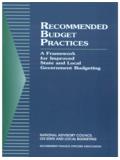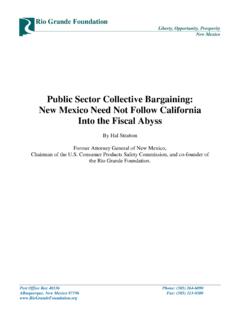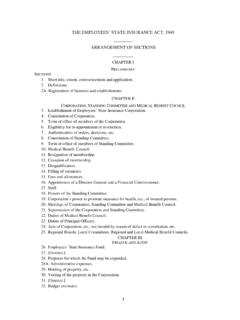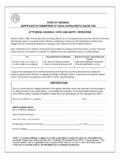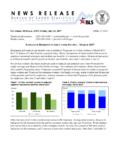Transcription of Center Governor’s
1 Center governor 's for local government Services Citizen's Guide to Pennsylvania local government Commonwealth of Pennsylvania Edward G. Rendell, governor Department of Community and Economic Development Dennis Yablonsky, Secretary Citizen's Guide to Pennsylvania local government Eighth Edition June 2003. Comments or inquiries on the subject matter of this publication should be addressed to: governor 's Center for local government Services Department of Community and Economic Development Commonwealth Keystone Building 400 North Street, 4th Floor Harrisburg, Pennsylvania 17120-0225. (717) 787-8158. 1-888-223-6837. E-mail: This and other publications are available for viewing or downloading free-of-charge from he Department of Community and Economic Development web site. Printed copies may be ordered and purchased through a private vendor as indicated on the web site.
2 Access Select Communities in PA. Select local government Services Select Publications Photo Credits Large Photo: Perry County Courthouse, courtesy of the Perry County Commissioners and the County Commissioners Association of Pennsylvania. Small Road Project Photo: Courtesy of the Pennsylvania State Association of Township Supervisors. No liability is assumed with respect to the use of information contained in this publication. Laws may be amended or court rulings made that could affect a particular procedure, issue or interpretation. The Department of Community and Economic Development assumes no responsibility for errors and omissions nor any liability for damages resulting from the use of information contained herein. Please contact your local solicitor for legal advise. Preparation of this publication was financed from appropriations of the General Assembly of the Commonwealth of Pennsylvania.
3 Copyright 2003, Pennsylvania Department of Community and Economic Development, all rights reserved. Table of Contents I. Pennsylvania local government .. 1. National government and local Units .. 1. State Constitutional Provisions.. 1. State Legislation .. 1. Home Rule and Optional Plans .. 2. County government .. 2. Municipal Powers .. 3. Home Rule Municipalities .. 3. Third Class Cities .. 4. Boroughs .. 4. Townships .. 4. Authorities .. 5. School Districts .. 5. II. The Voter and Elections .. 7. The Election Calendar .. 7. Elective Offices and Electoral Decisions .. 7. Political Parties and Political Bodies .. 8. Financial Disclosure Statements.. 9. Campaign Expense Reporting .. 9. The Election District Board .. 10. The County Board of Elections .. 10. The Secretary of the Commonwealth .. 11. Election Districts and Polling Places .. 11.
4 Registration of Voters.. 11. Determination of Residence .. 12. Voting Procedure .. 13. Absentee Voting .. 13. Counting the Votes .. 14. III. local Officers and Employees .. 16. The Constitution and local Public Office .. 16. Legal Provisions Relating to local Officials and Employees .. 17. Conflicts of Interest .. 17. Public Employee Labor Relations .. 18. The County .. 18. The City of Philadelphia.. 19. Pittsburgh and Scranton .. 19. Third Class Cities .. 20. Boroughs .. 20. Townships .. 21. Municipal Authorities.. 22. School Districts .. 22. Independent local Officials .. 23. Veterans and local government .. 23. Training .. 24. Pensions and Retirement .. 24. IV. local government Services and Expenditures .. 25. local government Functions .. 25. local government Expenditures and Debt .. 27. local Spending Procedures .. 28. V. Taxes and Revenues.
5 29. Real Estate Assessment .. 29. Tax Levies .. 31. Act 511 Taxes.. 32. Tax Collection .. 33. State Grants and Subsidies .. 33. National Financial Assistance .. 34. VI. The Property Owner.. 35. Eminent Domain.. 35. Deeds and Mortgages .. 35. Streets, Roads and Sidewalks .. 36. Water Supply and Waterworks.. 36. Sanitary Sewer Systems .. 36. Solid Waste.. 37. Special Assessments .. 37. Municipal Authorities.. 37. Planning .. 38. Zoning .. 38. Subdivision and Land Development Control .. 39. Building Regulations .. 39. Flood Management and Insurance .. 39. For More Information.. 40. VII. Public Safety .. 41. Criminal Justice .. 41. Police Protection.. 42. Fire Protection .. 43. Emergency Management .. 43. local Health Activities.. 43. Public Schools .. 45. School Districts .. 45. local Administration .. 45. Pupils .. 46. Special Education.
6 46. The State Department of Education .. 46. Higher Education .. 47. IX. Major local government Issues .. 49. Increasing Complexity .. 49. Professionalizing Personnel .. 49. local government Viability .. 50. Municipal Finances .. 50. Public Accountability .. 50. The Right to Know Law / The Sunshine Act .. 51. Conclusion .. 51. I. Pennsylvania local government local government in Pennsylvania is a mosaic of 5,149 individual units. All were established by the state or provincial government and operate under the laws of the Commonwealth. Each unit is distinct and independent of other local units, although they may overlap geographically and may act together to serve the public. In January 2003, there were 67 counties, 56 cities, 961 boroughs, one incorporated town, 1,548 townships (91. first class; 1,457 second class), 501 school districts and 2,015 authorities.
7 The number of local units has re- mained fairly stable for the past few decades with two major exceptions. After passage of school district legis- lation in 1963 and 1965, the number of school districts diminished radically. Authorities, born as local units during the depression years of the 1930's, have increased at a rapid pace since then. National government and local Units local government is one of the powers reserved to the states in Article X of the United states Constitution. Municipalities operate chiefly under the authority of state law. However, since the 1930's when the cities of the nation looked to the federal government for financial assistance to combat the problems brought on by the Great Depression, the national government has taken an active role in local government . Through financial subsidies, grants and technical assistance, federal agencies have stimulated development of low cost housing, urban renewal, improved educational facilities, modern highways, mass transit, health and welfare services and recreation facilities.
8 Federal community development block grants and other programs have strengthened direct links between federal and local government . National associations of local govern- ments lobby extensively in Congress and congressmen are active on behalf of local governments in their con- stituencies. Recent years have seen a shift to block grant programs and transfer of responsibilities to the states . State Constitutional Provisions The Pennsylvania Constitution authorizes the state to enact laws regulating local units of government . It out- lines basic requirements and rights. The Constitution requires periodic municipal redistricting, guarantees the right to select a home rule charter or an optional plan of government , and mandates uniform legislation for municipal boundary change procedure. The Constitution also prohibits special or local legislation by the General Assembly, sets up county government with elected row officers, permits classification of local govern- ments according to population, and requires taxation to be uniform upon the same classes of subjects.
9 The General Assembly is allowed to enact certain tax exemptions and special tax provisions because of age, disabil- ity, infirmity or poverty, and is authorized to prescribe debt limits based on municipal revenues. State Legislation Municipalities and school districts may be classified according to population; the General Assembly can legis- late separately for each class. There are four general types of municipalities in Pennsylvania: counties, cities, boroughs and townships. At the present time, there are nine classes of counties, four classes of cities, two classes of townships and five classes of school districts. Boroughs are not classified. Each class of municipality operates under its own code of laws. The codes set forth governmental structure and delineate general and specific powers of local government . They are the County Code, Second Class County Code, Third Class City Code, Borough Code, First Class Township Code, Second Class Township Code and Public School Code.
10 1. There is also extensive general legislation applying to local governments. Some examples of legislative provi- sions outside the local government codes are real property assessment, local nonproperty taxes, municipal borrowing, real estate tax collection, intergovernmental cooperation, municipal employee retirement, solid waste management, sewage facilities and planning and zoning. Significant general laws affecting local governments both grant powers and impose restrictions. The Pennsyl- vania Municipalities Planning Code empowers municipalities to plan their development and adopt zoning, subdivision and land development ordinances. The Pennsylvania Sewage Facilities Act regulates community and individual sewage disposal systems. The Solid Waste Management Act provides for solid waste collection and disposal. The Municipal Waste Planning, Recycling and Waste Reduction Act mandates recycling pro- grams in certain communities.


